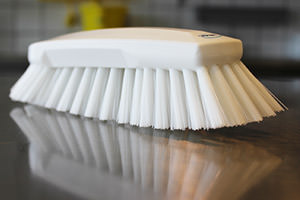Metal detectable plastics use in cleaning tools and utensils - does it reduce foreign body risk?
Foreign body contamination of foods can be a safety or quality issue, or both. Regardless, if a food is contaminated by a foreign body, the repercussions for the food business can be expensive and damaging.
Metal detection is a well established and effective method of reducing the risk of metal fragments in commercial food products. Control of plastic foreign bodies is more difficult. Metal detectable plastics have been developed with the intention that metal detectors can also be used for their detection but how detectable are these plastics?
In collaboration with Detectronic and Mettler Toledo, manufacturers of metal detection systems, and Zwick Roell, a materials testing group, Vikan have investigated the detectability of metal detectable plastics.
The investigations focussed on two key areas,
- the detectability of different metal detectable plastics and
- the detectability, durability, functionality and cleanability of metal detectable plastic brush bristles.
Detection Technology
Many food manufacturers are unaware that the metal detectability of any metal containing foreign body will depend on a number of things, including the;
- vibrations (physical and electronic)
- metal content of the contaminant, both the quantity and type of metal
- size of the metal containing contaminant
- orientation of the metal containing contaminant
- food product – size, composition
- food packaging
- speed of the conveyor belt
- detector used
- detector calibration
Each of these interfering factors has an effect on the detectability of the metal containing contaminant and the interferences are often cumulative and independently variable, as illustrated in Figure 1.





